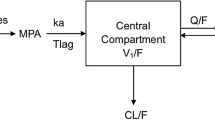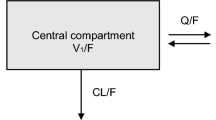Abstract
Mycophenolic acid is commonly prescribed in adult kidney transplant recipients for preventing graft rejection. A therapeutic target for total mycophenolic acid area under the concentration–time curve (30–60 mg h/L) has been established in adult kidney transplant recipients and widely referenced today. However, this specific target range does not adequately characterize mycophenolic acid-associated adverse effects. The primary objective of this qualitative and critical review was to characterize the exposure-toxicity relationships of mycophenolic acid in an attempt to determine whether exposure thresholds can be identified. The secondary objective was to determine the associations of clinical variables with specific adverse effects. The inclusion criteria consisted of all peer-reviewed papers in adult kidney transplant subjects (average study age > 18 years) with both exposure (area under the concentration–time curve) and toxicity data. The exclusion criteria were papers involving the pediatric population, studies lacking either area under the concentration–time curve or toxicity data, or studies with no apparent reported variations in area under the concentration–time curves. Of the 28 papers identified, inconsistent findings have been reported for the most frequently characterized adverse events of mycophenolic acid (gastrointestinal, infectious, and hematological), while promising exposure thresholds (i.e., > 40–60 mg h/L for total mycophenolic acid) have been suggested by a few studies. The roles of free mycophenolic acid exposure, mycophenolic acid metabolites, or clinical factors influencing the manifestation of the toxicities also remain to be clarified. Although it is not yet possible to define toxicity threshold(s) for the purpose of mycophenolic acid therapeutic drug monitoring, the information obtained and the limitations identified in this comprehensive literature body have provided a good foundation for future investigations.
Similar content being viewed by others
References
Staatz CE, Tett SE. Pharmacology and toxicology of mycophenolate in organ transplant recipients: an update. Arch Toxicol. 2014;88(7):1351–9. https://doi.org/10.1007/s00204-014-1247-1.
Le Meur Y, Borrows R, Pescovitz MD, Budde K, Grinyo J, Bloom R, et al. Therapeutic drug monitoring of mycophenolates in kidney transplantation: report of The Transplantation Society consensus meeting. Transplant Rev (Orlando). 2011;25(2):58–64. https://doi.org/10.1016/j.trre.2011.01.002.
Staatz CE, Tett SE. Clinical pharmacokinetics and pharmacodynamics of mycophenolate in solid organ transplant recipients. Clin Pharmacokinet. 2007;46(1):13–58.
Kiang TK, Ensom MH. Therapeutic drug monitoring of mycophenolate in adult solid organ transplant patients: an update. Expert Opin Drug Metab Toxicol. 2016;12(5):545–53. https://doi.org/10.1517/17425255.2016.1170806.
van Gelder T, Hilbrands LB, Vanrenterghem Y, Weimar W, de Fijter JW, Squifflet JP, et al. A randomized double-blind, multicenter plasma concentration controlled study of the safety and efficacy of oral mycophenolate mofetil for the prevention of acute rejection after kidney transplantation. Transplantation. 1999;68(2):261–6.
Kuypers DR, de Jonge H, Naesens M, de Loor H, Halewijck E, Dekens M, et al. Current target ranges of mycophenolic acid exposure and drug-related adverse events: a 5-year, open-label, prospective, clinical follow-up study in renal allograft recipients. Clin Ther. 2008;30(4):673–83.
Kiang TK, Ensom MH. Anti-rejection drugs. In: Murphy JE, editor. Clinical pharmacokinetics. 6th ed. Bethesda, MD: American Society of Health-System Pharmacists; 2017. p. 205–20.
Kiang TK, Ensom MH. Immunosuppressants. In: Beringer PE, editor. Basic clinical pharmacokinetics. 6th ed. Baltimore, MD: Wolters Kluwer; 2017. p. 320–57.
Helderman JH, Goral S. Gastrointestinal complications of transplant immunosuppression. J Am Soc Nephrol. 2002;13(1):277–87.
Zafrani L, Truffaut L, Kreis H, Etienne D, Rafat C, Lechaton S, et al. Incidence, risk factors and clinical consequences of neutropenia following kidney transplantation: a retrospective study. Am J Transplant. 2009;9(8):1816–25. https://doi.org/10.1111/j.1600-6143.2009.02699.x.
Filler G, Bendrick-Peart J, Christians U. Pharmacokinetics of mycophenolate mofetil and sirolimus in children. Ther Drug Monit. 2008;30(2):138-4. https://doi.org/10.1097/FTD.0b013e31816ba73a.
Sommerer C, Muller-Krebs S, Schaier M, Glander P, Budde K, Schwenger V, et al. Pharmacokinetic and pharmacodynamic analysis of enteric-coated mycophenolate sodium: limited sampling strategies and clinical outcome in renal transplant patients. Br J Clin Pharmacol. 2010;69(4):346–57. https://doi.org/10.1111/j.1365-2125.2009.03612.x.
Kagaya H, Miura M, Satoh S, Inoue K, Saito M, Inoue T, et al. No pharmacokinetic interactions between mycophenolic acid and tacrolimus in renal transplant recipients. J Clin Pharm Ther. 2008;33(2):193–201. https://doi.org/10.1111/j.1365-2710.2008.00906.x.
Pillans PI, Rigby RJ, Kubler P, Willis C, Salm P, Tett SE, et al. A retrospective analysis of mycophenolic acid and cyclosporin concentrations with acute rejection in renal transplant recipients. Clin Biochem. 2001;34(1):77–81.
Atcheson BA, Taylor PJ, Mudge DW, Johnson DW, Hawley CM, Campbell SB, et al. Mycophenolic acid pharmacokinetics and related outcomes early after renal transplant. Br J Clin Pharmacol. 2005;59(3):271–80.
Le Meur Y, Buchler M, Thierry A, Caillard S, Villemain F, Lavaud S, et al. Individualized mycophenolate mofetil dosing based on drug exposure significantly improves patient outcomes after renal transplantation. Am J Transplant. 2007;7(11):2496–503.
Gourishankar S, Houde I, Keown PA, Landsberg D, Cardella CJ, Barama AA, et al. The CLEAR study: a 5-day, 3-g loading dose of mycophenolate mofetil versus standard 2-g dosing in renal transplantation. Clin J Am Soc Nephrol. 2010;5(7):1282–9. https://doi.org/10.2215/CJN.09091209.
Le Meur Y, Thierry A, Glowacki F, Rerolle JP, Garrigue V, Ouali N, et al. Early steroid withdrawal and optimization of mycophenolic acid exposure in kidney transplant recipients receiving mycophenolate mofetil. Transplantation. 2011;92(11):1244–51. https://doi.org/10.1097/TP.0b013e318234e134.
Fu L, Huang Z, Song T, He S, Zeng D, Rao Z, et al. Short-term therapeutic drug monitoring of mycophenolic acid reduces infection: a prospective, single-center cohort study in Chinese living-related kidney transplantation. Transpl Infect Dis. 2014;16(5):760–6. https://doi.org/10.1111/tid.12275.
Glander P, Sommerer C, Arns W, Ariatabar T, Kramer S, Vogel EM, et al. Pharmacokinetics and pharmacodynamics of intensified versus standard dosing of mycophenolate sodium in renal transplant patients. Clin J Am Soc Nephrol. 2010;5(3):503–11. https://doi.org/10.2215/CJN.06050809.
Budde K, Tedesco-Silva H, Arns W, Shoker A, Zeier M, Klinger M, et al. Improved rejection prophylaxis with an initially intensified dosing regimen of enteric-coated mycophenolate sodium in de novo renal transplant recipients. Transplantation. 2011;92(3):321–7. https://doi.org/10.1097/TP.0b013e318223d7f3.
Arns W, Sommerer C, Glander P, Ariatabar T, Porstner M, May C, et al. A randomized trial of intensified vs. standard dosing for enteric-coated mycophenolate sodium in de novo kidney transplant recipients: results at 1 year. Clin Nephrol. 2013;79(6):421–31. https://doi.org/10.5414/cn107908.
Ding C, Xue W, Tian P, Ding X, Pan X, Xiang H, et al. Which is more suitable for kidney transplantation at the early post-transplantation phase in China: low dosing or standard dosing of enteric-coated mycophenolate sodium? Int J Clin Pract Suppl. 2014;181:10–6. https://doi.org/10.1111/ijcp.12401.
Peng W, Liu G, Huang H, Wu J, Chen J. Short-term intensified dosage regimen of mycophenolic acid is associated with less acute rejection in kidney transplantation from donation after circulatory death. Urol Int. 2018;101(4):443–9. https://doi.org/10.1159/000494361.
Heller T, van Gelder T, Budde K, de Fijter JW, Kuypers D, Arns W, et al. Plasma concentrations of mycophenolic acid acyl glucuronide are not associated with diarrhea in renal transplant recipients. Am J Transplant. 2007;7(7):1822–31.
van Agteren M, Armstrong VW, van Schaik RH, de Fijter H, Hartmann A, Zeier M, et al. AcylMPAG plasma concentrations and mycophenolic acid-related side effects in patients undergoing renal transplantation are not related to the UGT2B7-840G > A gene polymorphism. Ther Drug Monit. 2008;30(4):439–44. https://doi.org/10.1097/FTD.0b013e318180c709.
Tornatore KM, Meaney CJ, Wilding GE, Chang SS, Gundroo A, Cooper LM, et al. Influence of sex and race on mycophenolic acid pharmacokinetics in stable African American and Caucasian renal transplant recipients. Clin Pharmacokinet. 2015;54(4):423–34. https://doi.org/10.1007/s40262-014-0213-7.
Borni-Duval C, Caillard S, Olagne J, Perrin P, Braun-Parvez L, Heibel F, et al. Risk factors for BK virus infection in the era of therapeutic drug monitoring. Transplantation. 2013;95(12):1498–505. https://doi.org/10.1097/TP.0b013e3182921995.
Kuypers DR, Claes K, Evenepoel P, Maes B, Vanrenterghem Y. Clinical efficacy and toxicity profile of tacrolimus and mycophenolic acid in relation to combined long-term pharmacokinetics in de novo renal allograft recipients. Clin Pharmacol Ther. 2004;75(5):434–47. https://doi.org/10.1016/j.clpt.2003.12.009.
Gaston RS, Kaplan B, Shah T, Cibrik D, Shaw LM, Angelis M, et al. Fixed- or controlled-dose mycophenolate mofetil with standard- or reduced-dose calcineurin inhibitors: the Opticept trial. Am J Transplant. 2009;9(7):1607–19. https://doi.org/10.1111/j.1600-6143.2009.02668.x.
Okamoto M, Wakabayashi Y, Higuchi A, Kadotani Y, Ogino S, Ushigome H, et al. Therapeutic drug monitoring of mycophenolic acid in renal transplant recipients. Transplant Proc. 2005;37(2):859–60.
Satoh S, Tada H, Murakami M, Tsuchiya N, Inoue T, Togashi H, et al. The influence of mycophenolate mofetil versus azathioprine and mycophenolic acid pharmacokinetics on the incidence of acute rejection and infectious complications after renal transplantation. Transplant Proc. 2005;37(4):1751–3.
Mourad M, Malaise J, Chaib Eddour D, De Meyer M, Konig J, Schepers R, et al. Pharmacokinetic basis for the efficient and safe use of low-dose mycophenolate mofetil in combination with tacrolimus in kidney transplantation. Clin Chem. 2001;47(7):1241–8.
Mourad M, Malaise J, Chaib Eddour D, De Meyer M, Konig J, Schepers R, et al. Correlation of mycophenolic acid pharmacokinetic parameters with side effects in kidney transplant patients treated with mycophenolate mofetil. Clin Chem. 2001;47(1):88–94.
Kuypers DR, Vanrenterghem Y, Squifflet JP, Mourad M, Abramowicz D, Oellerich M, et al. Twelve-month evaluation of the clinical pharmacokinetics of total and free mycophenolic acid and its glucuronide metabolites in renal allograft recipients on low dose tacrolimus in combination with mycophenolate mofetil. Ther Drug Monit. 2003;25(5):609–22.
Kiang TKL, Partovi N, Shapiro RJ, Berman JM, Collier AC, Ensom MHH. Regression and genomic analyses on the association between dose-normalized mycophenolic acid exposure and absolute neutrophil count in steroid-free, de novo kidney transplant recipients. Clin Drug Investig. 2018;38(11):1011–22. https://doi.org/10.1007/s40261-018-0694-5.
Sobiak J, Kaminska J, Glyda M, Duda G, Chrzanowska M. Effect of mycophenolate mofetil on hematological side effects incidence in renal transplant recipients. Clin Transplant. 2013;27(4):E407–14. https://doi.org/10.1111/ctr.12164.
van Gelder T, Silva HT, de Fijter JW, Budde K, Kuypers D, Tyden G, et al. Comparing mycophenolate mofetil regimens for de novo renal transplant recipients: the fixed-dose concentration-controlled trial. Transplantation. 2008;86(8):1043–51. https://doi.org/10.1097/TP.0b013e318186f98a.
Sommerer C, Glander P, Arns W, Ariatabar T, Kramer S, Vogel EM, et al. Safety and efficacy of intensified versus standard dosing regimens of enteric-coated mycophenolate sodium in de novo renal transplant patients. Transplantation. 2011;91(7):779–85. https://doi.org/10.1097/TP.0b013e31820d3b9b.
Author information
Authors and Affiliations
Corresponding author
Ethics declarations
Funding
No funding or editorial assistance was received for the preparation of this article.
Conflict of Interest
Tony K.L. Kiang and Mary H.H. Ensom have no conflicts of interest that are directly related to the content of this article.
Rights and permissions
About this article
Cite this article
Kiang, T.K.L., Ensom, M.H.H. Exposure-Toxicity Relationships of Mycophenolic Acid in Adult Kidney Transplant Patients. Clin Pharmacokinet 58, 1533–1552 (2019). https://doi.org/10.1007/s40262-019-00802-z
Published:
Issue Date:
DOI: https://doi.org/10.1007/s40262-019-00802-z




